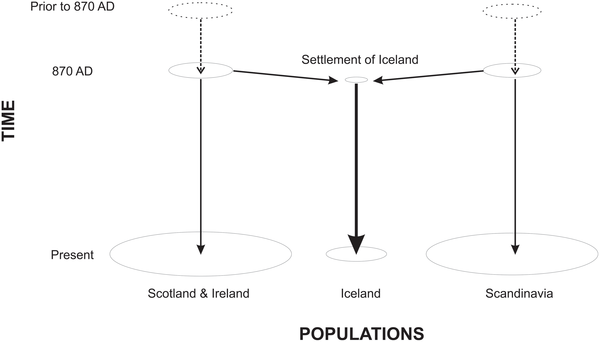The results confirm previous deCODE work that used genetics to test the history of Iceland as recorded in the sagas. These studies demonstrated that the country seems to have been settled by men from Scandinavia – the vikings – but that the majority of the original female inhabitants were from the coastal regions of Scotland and Ireland, areas that regularly suffered raids by vikings in the years around the settlement of Iceland 1100 years ago.
The current study further shows that the gene pool of contemporary Icelanders appears to have evolved rapidly over the intervening thousand years. As a result, the original female settlers are genetically less closely related to present-day Icelanders, and instead more closely related to the present day populations of Scotland, Ireland and Scandinavia, as well as those of northwestern and southwestern Europe.

A schematic representation of Iceland's population history. The circles represent the gene pools of the Scottish and Irish, Icelandic and Scandinavian population groups at different points in time. Circle diameter broadly reflects the relative population sizes. The vertical arrows represent the transmission of DNA between generations within populations, while the diagonal arrows represent the settlement of Iceland from 870 to 930 AD from Scotland, Ireland and Scandinavia.
This is a demonstration of a phenomenon known as 'genetic drift.' In essence, in any population certain individuals will have more offspring and, by chance and in this case over the course of 35 generations, many more descendants than others. And as a result, particularly in a small population, the genetic variety of the original population can decrease and change over time. In this study only mitochondrial DNA was studied, but the same phenomenon applies to the Y chromosome, which is passed from fathers to sons, and to any other part of the genome.
"This study is a major contribution to the use of ancient DNA studies in tracing the history not just of single populations, but of our species and how we spread from Africa to every corner of the globe," said Kari Stefansson, CEO of deCODE. "It is the first such study to be large enough to permit meaningful statistical methods to be applied to ancient DNA. We very much hope this will aid and encourage others to follow with large studies in other parts of the world."
CITATION: Helgason A, Lalueza-Fox C, Ghosh S, Sigurðardóttir S, Sampietro ML, et al. (2009) Sequences from First Settlers Reveal Rapid Evolution in Icelandic mtDNA Pool. PLoS Genet 5(1): e1000343. doi:10.1371/journal.pgen.1000343






Comments